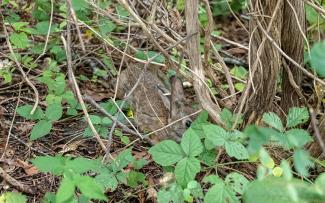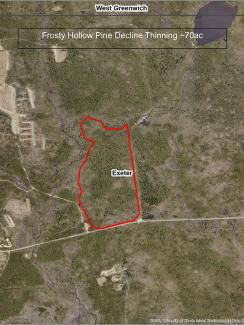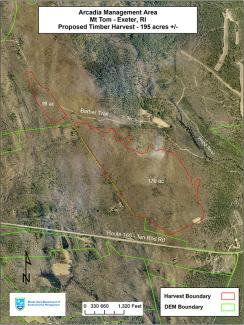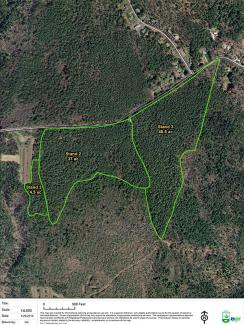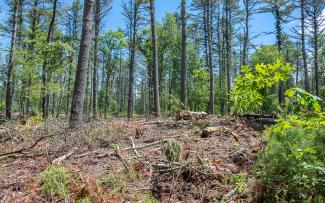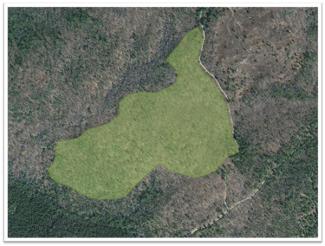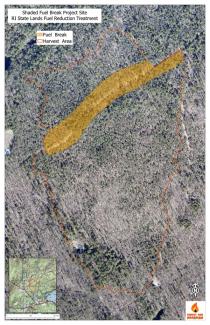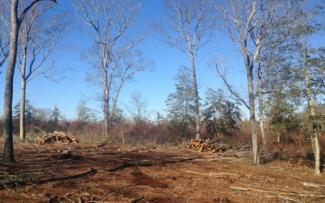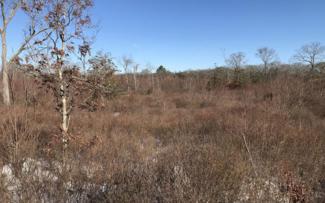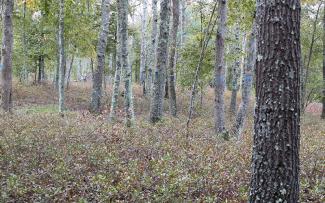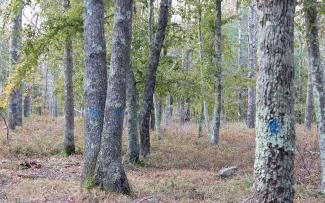State Land Stewardship: Forest Thinning and Timber Harvests
Rhode Island is the smallest and second most densely populated state with a land area of 1,214 square miles, a population of just over one million people, and approximately 420 miles of coastline. Rhode Island contains a variety of natural habitats that are populated by a diverse array of wildlife species. Maintaining a valued environmental, economic, and social/recreation resource is a priority for RIDEM and the 40,000 acres of state-owned land, for which the Division of Agriculture and Forest Environment shares responsibility with the Division of Fish & Wildlife, is highly valued.
The Arcadia management area is the state’s largest management area consisting of over 14,000 acres of mixed hardwoods, evergreens and fields. It was purchased through funds from the Federal Aid to Wildlife Restoration program made available through the Pittman-Robertson Act and along with matching funds through sales of hunting and fishing licenses and permits.
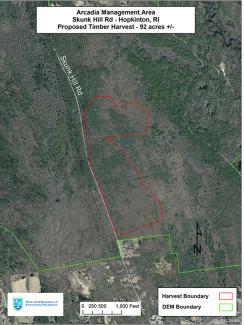
Year: 2019
Town: Hopkinton
Approx. Acres: 92
Silvicultural prescription: Salvage (Forest tent / Spongy moth)

Year: 2017
Town: Exeter
Approx. Acres: 20
Silvicultural prescription: Salvage (Forest tent / Spongy moth)
Carolina Management Area, located in the town of Richmond, encompasses over 2,300 acres of land stretching between Alton Carolina Rd (Rt. 91) in the South, to Kenyon Hill Trail to the North. Much of the property is comprised of upland forests with mixed red and white oak, beech, maple and white pine. Pitch pine communities with blueberry understory are scattered throughout as well.
George Washington State Management Area in Glocester is the second largest state management area in Rhode Island, next to the Arcadia State Management area, with 4,000 acres of land, the 226-acre freshwater Bowdish Reservoir, Clarkeville Pond and Wilbur Pond, 100-acre camping area with 45 well-spaced gravel sites, 10 miles of hiking trails, and so much more. The land was acquired during the 1930's by the US Government and developed by the Civilian Conservation Corps. During WWII the land was turned over to the State of RI.
The Great Swamp Management Area is a 3,500 acre property owned by the Rhode Island Department of Environmental Management. The Great Swamp boasts a variety of habitats, from old fields to shrublands, bogs, cedar swamps, and oak-
holly forest. All the habitat you see is carefully managed for wildlife. The shrublands are important habitat for birds and small mammals. This area offers the best spring birding in terms of the number of species; it is home to numerous and easy to find bluebird boxes and osprey nests and is the largest swap in New England, containing extensive forested freshwater wetlands, dominated by red maple and cedar swamp.
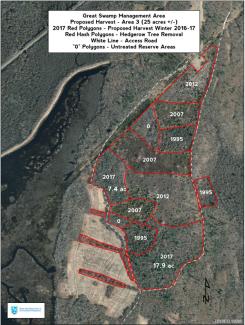
Year: 2016
Town: West Kingston
Approx. Acres: 23
Silvicultural prescription: Seed Tree, New England cottontail habitat
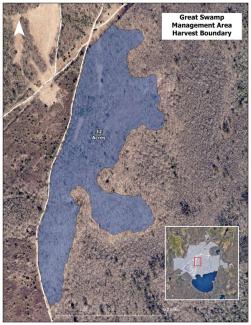
Year: 2024
Town: West Kingston
Approx. Acres: 32
Silvicultural prescription: Seed Tree, New England cottontail habitat
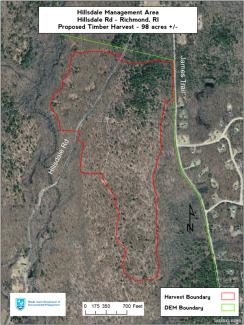
Year: 2018
Town: Richmond
Approx. Acres: 99
Silvicultural prescription: Salvage (Forest Tent / Spongy Moth)
Hillsdale Management Area, also known as the de Coppet Forest Preserve, was bequeathed to the state by Theakston de Coppet. This 1,825 acre parcel is filled with beautiful mature forests and hidden remnants of the historic mill town that once bustled around the Beaver River. The property is located in the designated Hillsdale Historical and Archeological District and contains remnants of nineteenth century rural industrial development, including foundations for a water powered stone mill, a woolen mill and a dye house, a cider mill, a dance hall and store, and worker housing. The property also includes a three-quarter mile long section of the Beaver River, a major tributary to the Pawcatuck River. The Pawcatuck River's 300 square mile watershed comprises most of southwestern Rhode Island and extends into Connecticut, and provides abundant clean groundwater that serves as the sole source of drinking water for more than 60,000 local residents. It supports roughly 70 percent of Rhode Island's globally imperiled species.
Nicholas Farm covers a total land area of 1429 acres in Coventry. The area is dominated by forest cover consisting of deciduous forest (688 acres) and evergreen forest (369 acres). Much of the conifer cover is pitch pine forest as a result of the dry soils which occur throughout the area. Wetlands (306 acres), agricultural fields (forty-one acres), and other areas (twenty-two acres) cover the balance of the area.
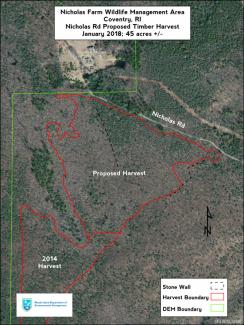
Year: 2018
Town: Coventry
Approx. Acres: 45
Silvicultural prescription: Seed Tree, Rabbit habitat / early successional
Tillinghast Pond Management Area is owned by The Nature Conservancy (TNC) and is managed in partnership with DEM and the Town of West Greenwich. Tillinghast Pond is actively managed to improve wildlife habitat. Under a 10-year forest stewardship plan, TNC hires Rhode Island loggers to create pockets of shrub and grassland habitat by removing areas of forest that have succumbed to invasive pests like gypsy moth caterpillars. These projects increase habitat diversity and are already benefitting hawks, bluebirds, and woodcocks.

Year: 2021
Town: West Greenwich
Approx. Acres: 65
Silvicultural prescription: Oak salvage and Timber stand improvement
Wickaboxet Wildlife Management Area covers a total land area of 678 acres. The land is dominated by a forested cover composed of primarily deciduous forest cover (589 acres - 86 percent of the area) and evergreen forest cover (twenty-seven acres - 3 percent of area). Wetlands cover the remainder of the parcel (sixty acres), consisting of forested and shrub-dominated wetlands.
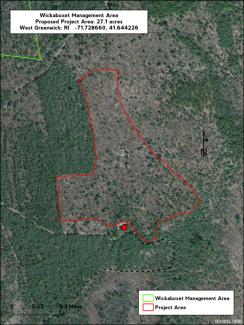
Year: 2015
Town: West Greenwich
Approx. Acres: 27
Silvicultural prescription: Seed Tree, regeneration harvest
Frequently Asked Questions
These projects are not clear cutting RI forests; DEM foresters strategically selected the trees to be harvested and mark them with blue paint.The work includes thinning out the tree canopy and removing dead trees, often harmed by repeated defoliation from forest pests like tent and spongy moth caterpillars, to promote healthy growth and improve its resilience to pests and storms. These harvests not only remove dying trees from the forest, but also decrease fire risks, stimulate the rural economy by providing register wood operators with timber to sell (often as wood chips, mulch, and firewood), and improve wildlife habitat. Low, dense shrubs and stumps remain to enhance wildlife habitat and promote healthy forest regrowth.
Silviculture is used by forest managers use to support healthy forest ecosystems and improve resilience in forest landscapes. It encompasses any of a number of treatments recommended by a forester to obtain a desired outcome or future forest composition. The prescription typically considers ecological, economic, and societal objectives and constraints. Good silvicultural practices are backed by sound science and support forest health, ecosystem resiliency, wetland conservation and watershed function, wildlife habitat, and carbon storage.
Yes. DEM publishes press releases and posts on social media to advise the public of upcoming projects. DEM is developing an outreach effort on timber harvesting projects to make community members and local officials aware of planned cutting operations on state-owned management areas and to improve the public's understanding of the benefits of forest stewardship for wildlife habitat, forest health and public safety. The targeted audience includes local officials; neighbors/homeowners; management area users such as hunters, fishers, and hikers; and other recreational partners.
DEM foresters supervise and monitor the harvest operations. All salvaged trees are strategically selected and marked with blue paint. Tree harvesting is performed by Rhode Island registered wood operators who bid on the project; harvested trees are often used for wood chips, mulch, and firewood.
Just like people, forests age overtime, and during the different stages of life, called stages of “succession” they support different kinds of wildlife. Forests can look very different depending on the type and age. Some are open with tall trees, these are very old, “mature” forests and others are so thick you can barely walk through, these are “young” forests.
Young forests (also called early successional forests) have become less and less common due to humans repressing the natural occurrences, such as fires and flooding from beavers, that forests need to reset. Young forests only last for 10 to 20 years but are crucial to many Rhode Island species, such as New England cottontail, woodcock, box turtle, ruffled grouse, and bobcat.
The New England cottontail (NEC) is native to the Northeast and was recently a candidate for listing under the Federal Endangered Species Act. Potential causes for NEC decline include loss of young forest habitat, predation, and competition with the non-native Eastern cottontail. Locally in Rhode Island, NEC have dramatically declined in distribution and abundance since the 1980s. Currently, the NEC is listed in RI as a Species of Greatest Conservation Need and is the focus of a large, coordinated effort to conserve the species.


